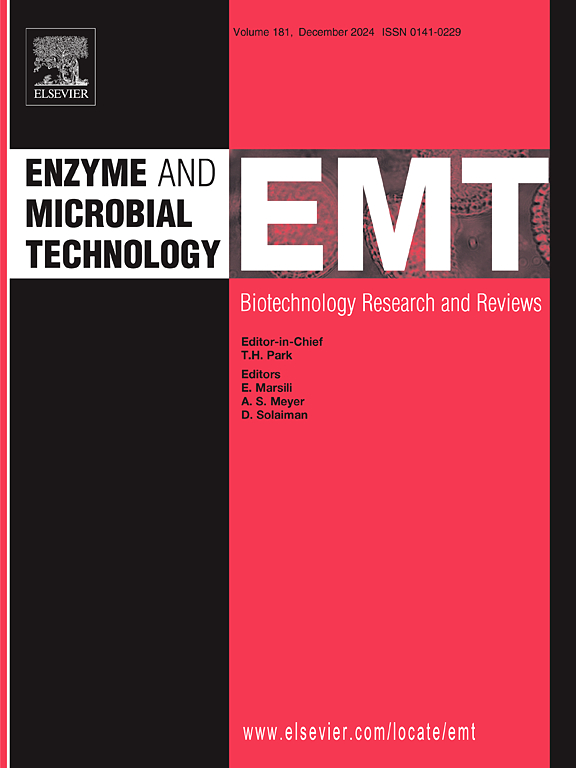嗜热毛菌GH6家族耐热纤维素酶的鉴定,具有高纤维二糖和离子液体耐受性
IF 3.7
3区 生物学
Q2 BIOTECHNOLOGY & APPLIED MICROBIOLOGY
引用次数: 0
摘要
将木质纤维素生物质有效转化为可发酵糖需要既耐热又耐离子液体(ILs)等抑制剂的纤维素酶。耐热酶在工业应用中特别有价值,因为它们在高温下长时间保持活性,提高产品产量,降低工艺成本。本研究从嗜热真菌Thermochaetoides thermophila (Chaetomium thermophilum)中克隆并鉴定了GH6家族纤维素酶CtCel6C。在55℃和pH 6.0条件下,CtCel6C对羧甲基纤维素(CMC-Na)的比活性为28 U/mg,在最佳pH和温度(55℃和pH 6.0)下,20 h后,CtCel6C的比活性仍保持90% %。CtCel6C表现出广泛的底物特异性,可以有效水解低聚糖、可溶性底物(CMC和大麦β-葡聚糖)和不溶性底物(如Avicel),始终如一地产生纤维素二糖作为唯一产物,优于其他来自嗜热c菌的GH6纤维素生物水解酶。尽管由于在c端环中缺乏15个残基延伸而具有开放的活性位点裂缝,但CtCel6C保留了过程纤维素生物水解酶的生化特征,而不是来自GH6家族的内切葡聚糖酶的生化特征。在McIlvaine缓冲液(pH 6.0)和海水中,该酶对纤维素二糖、葡萄糖和20% % (v/v)的离子液体1-乙基-3-甲基咪唑醋酸盐([C2mim][OAc])均表现出较高的耐受性。CtCel6C卓越的IL耐受性使其成为整合到生物质糖化工业酶混合物中的有希望的候选者。本文章由计算机程序翻译,如有差异,请以英文原文为准。
Identification of a thermostable GH6 family cellulase from chaetomium thermophilum exhibiting high cellobiose and ionic liquid tolerance
Efficient conversion of lignocellulosic biomass into fermentable sugars requires cellulases that are both thermostable and tolerant to inhibitors such as ionic liquids (ILs). Thermostable enzymes are particularly valuable for industrial applications, as they maintain activity at elevated temperatures for extended periods, improve product yield, and reduce process costs. In this study, we cloned and characterized CtCel6C, a GH6 family cellulase, from the thermophilic fungus Thermochaetoides thermophila (Chaetomium thermophilum). CtCel6C exhibited a specific activity of 28 U/mg on carboxymethyl cellulose (CMC-Na) at 55 °C and pH 6.0, retaining 90 % of its specific activity after 20 h at optimum pH and temperature (55 °C and pH 6.0). CtCel6C demonstrated broad substrate specificity, effectively hydrolyzing oligosaccharides, soluble substrates (CMC and barley β-glucan), and insoluble substrates such as Avicel, consistently producing cellobiose as the sole product and outperforming other GH6 cellobiohydrolases from C. thermophilum. Despite having an open active-site cleft due to a lack of a fifteen-residue stretch in the C-terminal loop, CtCel6C retains the biochemical characteristics of a processive cellobiohydrolase rather than those of an endoglucanase from the GH6 family. The enzyme also exhibited high tolerance to cellobiose, glucose, and to 20 % (v/v) of the ionic liquid 1-ethyl-3-methylimidazolium acetate ([C2mim][OAc]), in both McIlvaine buffer (pH 6.0) and seawater. The remarkable IL tolerance of CtCel6C makes it a promising candidate for integration into industrial enzyme cocktails for biomass saccharification.
求助全文
通过发布文献求助,成功后即可免费获取论文全文。
去求助
来源期刊

Enzyme and Microbial Technology
生物-生物工程与应用微生物
CiteScore
7.60
自引率
5.90%
发文量
142
审稿时长
38 days
期刊介绍:
Enzyme and Microbial Technology is an international, peer-reviewed journal publishing original research and reviews, of biotechnological significance and novelty, on basic and applied aspects of the science and technology of processes involving the use of enzymes, micro-organisms, animal cells and plant cells.
We especially encourage submissions on:
Biocatalysis and the use of Directed Evolution in Synthetic Biology and Biotechnology
Biotechnological Production of New Bioactive Molecules, Biomaterials, Biopharmaceuticals, and Biofuels
New Imaging Techniques and Biosensors, especially as applicable to Healthcare and Systems Biology
New Biotechnological Approaches in Genomics, Proteomics and Metabolomics
Metabolic Engineering, Biomolecular Engineering and Nanobiotechnology
Manuscripts which report isolation, purification, immobilization or utilization of organisms or enzymes which are already well-described in the literature are not suitable for publication in EMT, unless their primary purpose is to report significant new findings or approaches which are of broad biotechnological importance. Similarly, manuscripts which report optimization studies on well-established processes are inappropriate. EMT does not accept papers dealing with mathematical modeling unless they report significant, new experimental data.
 求助内容:
求助内容: 应助结果提醒方式:
应助结果提醒方式:


